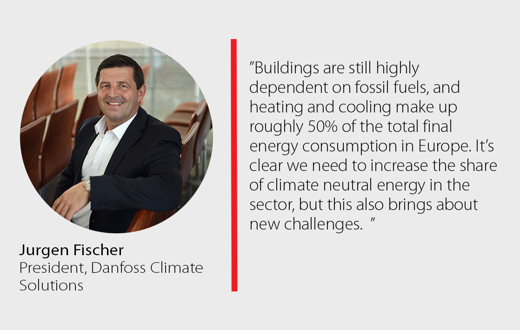
By Jürgen Fischer, President Danfoss Climate Solutions
This summer marked the European Commission’s release of the Fit for 55 package. This is a new set of proposals to overhaul of the EU’s entire energy and climate legislation and align it with the EU’s target to cut climate emissions by 55% by 2030.
One of the key things to watch will be whether the package will succeed in creating the right framework for a truly integrated energy system. This is key to achieving the 2030 ambition, especially in connection to heating and cooling buildings.

Empowering climate friendly action
Buildings are still highly dependent on fossil fuels, and heating and cooling make up roughly 50% of the total final energy consumption in Europe (EPEE report). It’s clear we need to increase the share of climate neutral energy in the sector, but this also brings about new challenges.
With wind and solar becoming increasingly mainstream, it is no longer a question of how much renewable energy we can produce, but rather how much can we integrate into our existing energy system. We need innovative solutions that will help us utilize and store intermittent renewable energy cost effectively. That’s where energy system integration comes in.
Energy system integration is not a set of specific technologies, but rather a concept for how several technologies can work together. The European Commission defines energy system integration as “the coordinated planning and operation of the energy system ‘as a whole’ across multiple energy carriers, infrastructures, and consumer sectors.” Basically, energy system integration is about bringing energy efficiency to the next level and using our resources more efficiently and smarter across all sectors of the economy. Denmark is strongly supporting energy system integration, as it could almost halve the cost of the Danish goal to reduce emissions by 70% by 2030. It is seen as the key pathway towards effective and affordable decarbonization.
It is not an easy undertaking to align the entire climate and energy policy framework under this concept, but there are several obvious points where we can start to harvest the synergies between different sectors.
1. Realizing the potential of district energy
There is a huge potential to scale up district energy in Europe. District energy is one of the most cost-effective solutions for decarbonizing buildings, especially in urban areas. In fact, 50% of the heat demand in Europe could be covered with district energy in a sustainable way. Today, it makes up only about 14% of the market. Tremendous benefits can be achieved by integrating district heating with electricity grids with the help of power-to-heat solutions such as large-scale heat pumps.
Studies show that primary energy use could be reduced by 13% and energy system costs reduced by 70 billion EUR per year (compared to a conventionally decarbonized system). Using district heating systems as thermal storage can balance the electricity system while decarbonizing heating and cooling. To do this, a more ambitious policy framework for district energy is needed, including the introduction of mandatory local energy planning, and improving coordination between district energy and electricity operators.
2. Utilizing excess heat – cooling is the new heating
In our traditional energy systems, the excess heat given off by cooling equipment is wasted. In more circular systems, this excess heat from supermarkets or data centers is captured and distributed to nearby homes and buildings through low-temperature heating systems combined with large-scale heat pumps. This approach has the potential to significantly reduce the heating demand while improving supply-side efficiency and avoiding costs for energy storage and infrastructure.
Let’s have a closer look at data centers. Their demand for cooling is very high since computer servers need to be kept at specific temperatures. In fact, data centers use 1% of the electricity consumed globally and this is increasing, and almost all of this electricity is transformed into heat. Traditionally the heat generated by computer servers is emitted as waste, but with excess heat recovery 97% of the energy consumed in data centers can be re-used as heat.
To realize the full potential of excess heat, policymakers must assess it on equal footing with renewable heating and remove existing barriers to waste heat recovery, such as expensive taxes or administrative burdens.
3. Accelerating the digital transformation
To make the most of these solutions, we must also roll out digital tools to manage the increasing complexity of our energy systems. With connected devices and artificial intelligence come new means to gather and evaluate data, monitor and measure energy consumption and performance, conduct preventative maintenance, and match demand and supply across sectors. Strong and reliable data can help energy operators and stakeholders coordinate and work together where they have previously been siloed. It will be important to update current legislation to ensure digital solutions are widely rolled out in buildings, including public and residential buildings.
Energy system integration in action
Energy system integration is not a theoretical possibility. With today’s technology tremendous strides have already been demonstrated. One example was executed by Energy Lab Nordhavn, in Copenhagen. The project has developed innovative ways to integrate existing solutions for renewables and energy efficiency into an intelligent, flexible energy system. This includes capturing excess heat from a local supermarket to heat surrounding buildings and using large scale heat pumps to connect the electricity and heating grids.
For the heating and cooling sector, energy system integration is a necessary step to reduce greenhouse gas emissions and achieve the goals of the Fit for 55 package. The technology we need already exists – be it district heating, heat pumps, building automation, or heat recovery. We must work together across sectors to accelerate the roll out of these solutions. 2030 is quickly approaching and now is the time to accelerate action.




